
Forage is a plant material eaten by grazing livestock. Historically, the term forage has meant only plants eaten by the animals directly as pasture, crop residue, or immature cereal crops, but it is also used more loosely to include similar plants cut for fodder and carried to the animals, especially as hay or silage.

Festuca (fescue) is a genus of flowering plants belonging to the grass family Poaceae. They are evergreen or herbaceous perennial tufted grasses with a height range of 10–200 cm (4–79 in) and a cosmopolitan distribution, occurring on every continent except Antarctica. The genus is closely related to ryegrass (Lolium), and recent evidence from phylogenetic studies using DNA sequencing of plant mitochondrial DNA shows that the genus lacks monophyly. As a result, plant taxonomists have moved several species, including the forage grasses tall fescue and meadow fescue, from the genus Festuca into the genus Lolium, or alternatively into the segregate genus Schedonorus.

Festuca ovina, sheep's fescue or sheep fescue, is a species of grass. It is sometimes confused with hard fescue.

Deschampsia cespitosa, commonly known as tufted hairgrass or tussock grass, is a perennial tufted plant in the grass family Poaceae. Distribution of this species is widespread including the eastern and western coasts of North America, parts of South America, Eurasia and Australia.

Festuca pratensis, the meadow fescue, is a perennial species of grass, which is often used as an ornamental grass in gardens, and is also an important forage crop.

Festuca rubra is a species of grass known by the common name red fescue, creeping red fescue or the rush-leaf fescue. It is widespread across much of the Northern Hemisphere and can tolerate many habitats and climates. It is best adapted to well-drained soils in cool, temperate climates; it prefers shadier areas and is often planted for its shade tolerance. Wild animals browse it, but it has not been important for domestic forage due to low productivity and palatability. It is also an ornamental plant for gardens.
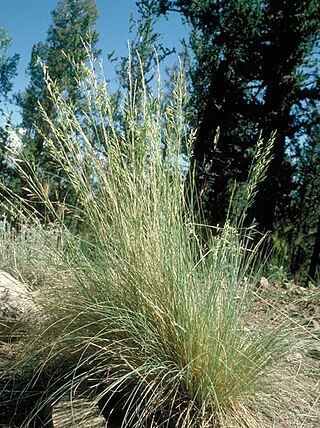
Festuca arizonica, commonly called Arizona fescue, is a grass found in western North America, in the southwest United States and northern Mexico. This species also has the common names mountain bunchgrass and pinegrass.

Festuca californica is a species of grass known by the common name California fescue.

Festuca idahoensis is a species of grass known by the common names Idaho fescue and blue bunchgrass. It is native to western North America, where it is widespread and common. It can be found in many ecosystems, from shady forests to open plains grasslands.
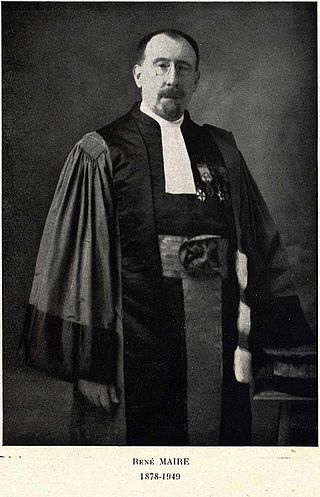
René Charles Joseph Ernest Maire was a French botanist and mycologist. His major work was the Flore de l'Afrique du Nord in 16 volumes published posthumously in 1953. He collected plants from Algeria, Morocco, France, and Mali for the herbarium of the National Botanic Garden of Belgium.

Tussock grasses or bunch grasses are a group of grass species in the family Poaceae. They usually grow as singular plants in clumps, tufts, hummocks, or bunches, rather than forming a sod or lawn, in meadows, grasslands, and prairies. As perennial plants, most species live more than one season. Tussock grasses are often found as forage in pastures and ornamental grasses in gardens.
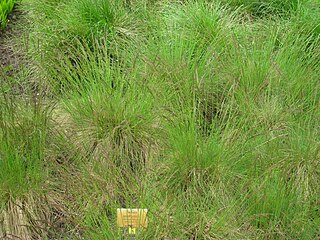
Festuca amethystina, also known as the tufted fescue, is a species of grass in the family Poaceae. It is native to Europe, including Turkey. It is perennial and grows in temperate biomes. It was first described in 1753 by Carl Linnaeus.

Festuca vivipara, the viviparous sheep's-fescue, is a species of grass native to northern Europe, northern Asia, and subarctic North America. The specific epithet vivipara is Latin, referring to the florets' alteration to leafy tufts. The plant can have a diploid number of 28, 49, 56, or 63, though numbers of 21, 35, and 42 have also been reported.

Festuca thurberi is a species of grass known by the common name Thurber's fescue. It is native to a section of the western United States encompassing New Mexico, Utah, Colorado, and Wyoming. It probably also occurs in parts of Arizona.

Festuca gigantea, or giant fescue, is a plant species in the grass family, Poaceae. Because this and other members of Festuca subgenus Schedonorus have more in common morphologically with members of the genus Lolium than with Festuca and often produce fertile hybrids with other Lolium species, Festuca gigantea has been recently published as Lolium giganteum(L.) Darbysh. (1993) and then as Schedonorus giganteus(L.) Holub (1998). Sources vary as to which placement is more acceptable.
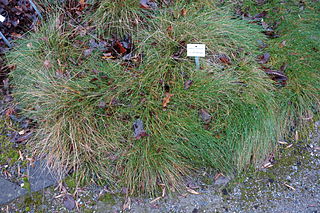
Festuca armoricana, the Breton fescue, is a species of grass endemic to Europe. It was first described in 1975 by Kerguélen.
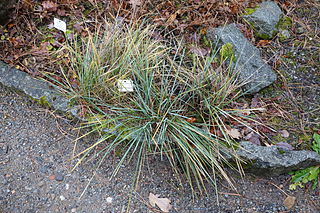
Festuca paniculata is a grass with culms 60–120 cm long, endemic to central, southwestern, and southeastern Europe and northern Africa. It was first described in 1913.
Festuca edlundiae, commonly known as Edlund's fescue, is a native, perennial tufted grass found in Alaska, Canadian arctic islands, northern Greenland, far eastern arctic Russia and Svalbard. The specific name honours Doctor Sylvia Edlund, a Canadian botanist. It was first described by Susan Aiken, Laurie Consaul and Leonard Lefkovitch in 1995.

Festuca brachyphylla, commonly known as alpine fescue or short-leaved fescue, is a grass native to Eurasia, North America, and the Arctic. The grass is used for erosion control and revegetation. The specific epithet brachyphylla means "short-leaved". The grass has a diploid number of 28, 42, or 44. This species was first described in 1827.
Festuca ampla is a species of grass described and named by the botanist Eduard Hackel in 1880. F. ampla often thrives in habitats that include humid environments, arid soil, and sandy areas. This species grows in temperate biomes and is a perennial. This species is native to Portugal, Spain, and Morocco. Its' common names are Ample Fescue, Ample Meadow Grass, and Ample Meadow Fescue.


















